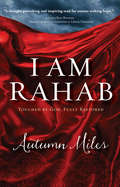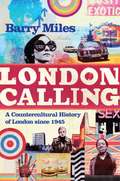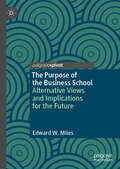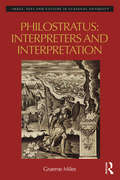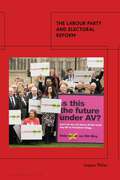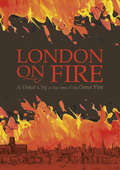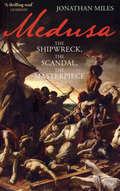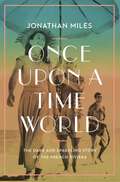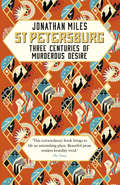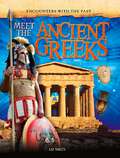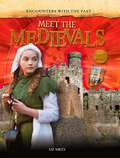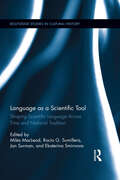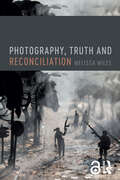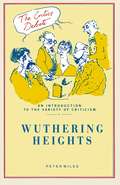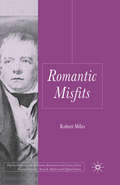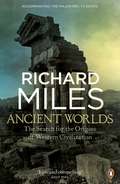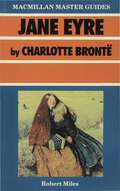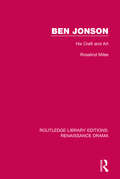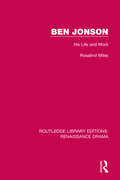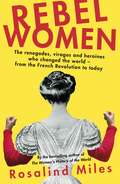- Table View
- List View
I Am Rahab: Touched By God, Fully Restored
by Autumn MilesWhat do you do when you can relate more to Jezebel, Ahab, or Eve than Esther or Mary? To her surprise and joy, author Autumn Miles discovered most of the heroes of the Bible were plagued with the same problem. They were ordinary people who sinned, but God's love, mercy, and truth proved greater.I Am Rahab provides a better understanding of God, with a focus on the breadth of his reach to use and redeem all things for the good of his purposes, and for their benefit as his beloved children. You will find comfort in relating to Rahab and to Autumn's own raw story of surviving domestic abuse and will be encouraged to know you are not alone in a life disrupted by bad choices, nor are you meant to stay there. You can move forward from your past and have an abundant future.
London Calling: A Countercultural History of London since 1945
by Barry MilesLondon has long been a magnet for aspiring artists and writers, musicians and fashion designers seeking inspiration and success. In London Calling, Barry Miles explores the counter-culture - creative, avant garde, permissive, anarchic - that sprang up in this great city in the decades following the Second World War. Here are the heady post-war days when suddenly everything seemed possible, the jazz bars and clubs of the fifties, the teddy boys and the Angry Young Men, Francis Bacon and the legendary Colony Club, the 1960s and the Summer of Love, the rise of punk and the early days of the YBAs. The vitality and excitement of this time and years of change - and the sheer creative energy in the throbbing heart of London - leap off the pages of this evocative and original book.
The Purpose of the Business School: Alternative Views and Implications for the Future
by Edward W. MilesIn the mid-20th century, university-based business schools re-oriented themselves to increased alignment with the preferences of the university and decreased alignment with the preferences of business. This re-alignment has caused multiple observers to question the effectiveness of current-day business schools. For example, recent discussions have lamented that business schools are engaged in research that does not influence the practice of business. This book engages these debates, arguing that all judgments about the effectiveness of business schools are rooted in assumptions about what the purposes of the business school appropriately are and that many of those assumptions are unstated and not subjected to debate. The author weaves a unique blend of complexity theory, philosophy of science, and the nature of professions to articulate those goals and assess the effectiveness at meeting them. The book traces parallel discussions regarding the purpose of the university in the writings of Aristotle and Wilhelm von Humboldt and ties those discussions to current debates. This book will inform business faculty and administrators of the degree to which university-based business schools are balancing multiple purposes which include discovery of knowledge, creating knowledge that informs the practice of business, training professionals, and instilling ethical principles in its training of those professionals.
Philostratus: Interpreters And Interpretation (Image, Text, and Culture in Classical Antiquity #1)
by Graeme MilesPhilostratus is one of the greatest examples of the vitality and inventiveness of the Greek culture of his period, at once a one-man summation of contemporary tastes and interests and a strikingly individual re-inventor of the traditions in which he was steeped. This Roman-era engagement with the already classical past set important precedents for later understandings of classical art, literature and culture. This volume examines the ways in which the labyrinthine Corpus Philostrateum represents and interrogates the nature of interpretation and the interpreting subject. Taking ‘interpretation’ broadly as the production of meaning from objects that are considered to bear some less than obvious significance, it examines the very different interpreter figures presented: Apollonius of Tyana as interpreter of omens, dreams and art-works; an unnamed Vinetender and the dead Protesilaus as interpreters of heroes; and the sophist who emotively describes a gallery full of paintings, depicting in the process both the techniques of educated viewing and the various errors and illusions into which a viewer can fall.
Philostratus: Interpreters and Interpretation (Image, Text, and Culture in Classical Antiquity #1)
by Graeme MilesPhilostratus is one of the greatest examples of the vitality and inventiveness of the Greek culture of his period, at once a one-man summation of contemporary tastes and interests and a strikingly individual re-inventor of the traditions in which he was steeped. This Roman-era engagement with the already classical past set important precedents for later understandings of classical art, literature and culture. This volume examines the ways in which the labyrinthine Corpus Philostrateum represents and interrogates the nature of interpretation and the interpreting subject. Taking ‘interpretation’ broadly as the production of meaning from objects that are considered to bear some less than obvious significance, it examines the very different interpreter figures presented: Apollonius of Tyana as interpreter of omens, dreams and art-works; an unnamed Vinetender and the dead Protesilaus as interpreters of heroes; and the sophist who emotively describes a gallery full of paintings, depicting in the process both the techniques of educated viewing and the various errors and illusions into which a viewer can fall.
The Labour Party and Electoral Reform
by Jasper MilesThe issue of electoral reform has divided the Labour Party since its inception, but only for a brief period in the early 20th century has the Party been committed to reforming first-past-the-post (FPTP). Now, having suffered four successive general election defeats, the Labour Party will have to reconsider its electoral strategy if it is, once again, to become a party of government. For some, a commitment to electoral reform is an indispensable step to widen support, transform the Party, and unlock British Politics. For others, the present system still offers the best hope of majority Labour governments, avoiding deals with the Party's rivals and the watering down of Labour's social democratic agenda. This book explores the Labour Party's approaches towards reforming the Westminster electoral system, and more widely, its perception of electoral pacts and coalition government. The opening chapters chart the debate from the inception of the Party up to the electoral and political impact of Thatcherism. From there, the book takes a closer look at significant recent events, including the Plant Report, the Jenkins Commission, the end of New Labour, the Alternative Vote Referendum, and closing with the Labour leadership containing the matter at Party Conference, 2021. Importantly, it offers an assessment of the pressures and environment in which Labour politicians have operated. Extensive elite-level interviews and new archival research offers the reader a comprehensive and definitive account of this debate.
The Labour Party and Electoral Reform
by Jasper MilesThe issue of electoral reform has divided the Labour Party since its inception, but only for a brief period in the early 20th century has the Party been committed to reforming first-past-the-post (FPTP). Now, having suffered four successive general election defeats, the Labour Party will have to reconsider its electoral strategy if it is, once again, to become a party of government. For some, a commitment to electoral reform is an indispensable step to widen support, transform the Party, and unlock British Politics. For others, the present system still offers the best hope of majority Labour governments, avoiding deals with the Party's rivals and the watering down of Labour's social democratic agenda. This book explores the Labour Party's approaches towards reforming the Westminster electoral system, and more widely, its perception of electoral pacts and coalition government. The opening chapters chart the debate from the inception of the Party up to the electoral and political impact of Thatcherism. From there, the book takes a closer look at significant recent events, including the Plant Report, the Jenkins Commission, the end of New Labour, the Alternative Vote Referendum, and closing with the Labour leadership containing the matter at Party Conference, 2021. Importantly, it offers an assessment of the pressures and environment in which Labour politicians have operated. Extensive elite-level interviews and new archival research offers the reader a comprehensive and definitive account of this debate.
London on Fire: A Great City At The Time Of The Great Fire
by John C. MilesWelcome to London in the late 17th century. After years of Civil War and repressive Puritan rule, King Charles II is back in town and his restoration has brought new life to this great city. The theatres are open again, markets and shops are thriving and the streets are crowded. People are talking about new ideas in science and architecture and experimenting with new fashions. This book takes you on a journey across London at this time, telling you about its 'five-star' sights and their history. It also explains the key events of the time: the reasons for the Restoration, the arrival of the Plague and, of course, the Great Fire of 1666 and the new London that arose out of its ashes. Published to coincide with the 350th anniversary of the Great Fire, this book gives older children a much broader context for this famous event. With a mixture of maps, archive images and present day photography, it acts as a wonderful guide both to London in the 1660s and how its legacy can still be found in the capital today. London on Fire is an ideal resource for readers aged 10+ and supports the history curriculum at Key Stage 3.
Medusa: The Shipwreck, The Scandal, The Masterpiece
by Jonathan MilesIn June 1816, the Medusa, flagship of a French expedition to repossess the colony of Senegal from the British, set sail but ran aground off the desolate West African coast. The evacuation of the frigate was chaotic and cowardly - 146 men and one woman were herded aboard a makeshift raft which was then abandoned in mid-ocean, cut loose by the convoy of lifeboats which had pledged to tow it to safety. The drifting raft carried those who survived to the very frontiers of human experience. Crazed, parched and starving, the diminishing band slaughtered mutineers, ate their dead companions and organized a tactical extermination of the weakest among them. Among the handful of survivors from the raft were two men whose written account of the tragedy catalogued the trail of government incompetence, indifference, and cover-up. Their book became a best-seller which rocked Europe and inspired the promising artist, Théodore Géricault. Reeling from an illicit affair with his attractive young aunt, he threw himself into an exhaustive study of the Medusa tragedy.Set in the politically fragile world of Restoration France, the murk of Georgian London and along the dangerous West African coast where the French were covertly regenerating the outlawed slave trade, Medusa witnesses error and outrage turned into a bestseller, and that bestseller transformed into one of the masterpieces of Western art.
Once Upon a Time World: The Dark and Sparkling Story of the French Riviera
by Jonathan MilesA Financial Times 'Book to Read in 2023'In 1835, Lord Brougham founded Cannes, introducing bathing and the manicured lawn to the wilds of the Mediterranean coast. Today, much of that shore has become a concrete mass from which escape is an exclusive dream. In the intervening years, the stretch of seaboard from the red mountains of the Esterel to the Italian border hosted a cultural phenomenon well in excess of its tiny size. A mere handful of towns and resorts created by foreign visitors - notably English, Russian and American - attracted the talented, rich and famous as well as those who wanted to be. For nearly two centuries of creativity, luxury, excess, scandal, war and corruption, the dark and sparkling world of the Riviera was a temptation for everybody who was anybody. Often frivolous, it was also a potent cultural matrix that inspired the likes of Picasso, Matisse, Coco Chanel, Scott Fitzgerald, Cole Porter, James Baldwin, Catherine Mansfield, the Rolling Stones, Sartre and Stravinsky.In Once Upon a Time World, Jonathan Miles presents the remarkable story of the small strip of French coast that lured the world to its shores. It is a wild and unforgettable tale that follows the Riviera's transformation from paradise and wilderness to a pollution imperilled concrete jungle.
St Petersburg: Three Centuries of Murderous Desire
by Jonathan Miles'This extraordinary book brings to life an astonishing place. Beautiful prose renders brutality vivid' The Times - BOOK OF THE WEEK From Peter the Great to Putin, this is the unforgettable story of St Petersburg – one of the most magical, menacing and influential cities in the world. St Petersburg has always felt like an impossible metropolis, risen from the freezing mists and flooded marshland of the River Neva on the western edge of Russia. It was a new capital in an old country. Established in 1703 by the sheer will of its charismatic founder, the homicidal megalomaniac Peter-the-Great, its dazzling yet unhinged reputation was quickly fashioned by the sadistic dominion of its early rulers.This city, in its successive incarnations – St Petersburg; Petrograd; Leningrad and, once again, St Petersburg – has always been a place of perpetual contradiction. It was a window on to Europe and the Enlightenment, but so much of the glory of Russia was created here: its literature, music, dance and, for a time, its political vision. It gave birth to the artistic genius of Pushkin and Dostoyevsky, Tchaikovsky and Shostakovich, Pavlova and Nureyev. Yet, for all its glittering palaces, fairytale balls and enchanting gardens, the blood of thousands has been spilt on its snow-filled streets. It has been a hotbed of war and revolution, a place of siege and starvation, and the crucible for Lenin and Stalin’s power-hungry brutality.In St Petersburg, Jonathan Miles recreates the drama of three hundred years in this absurd and brilliant city, bringing us up to the present day, when – once more – its fate hangs in the balance. This is an epic tale of murder, massacre and madness played out against squalor and splendour. It is an unforgettable portrait of a city and its people.
Meet the Ancient Greeks (Encounters with the Past)
by Liz MilesDare you step into the past? When a mysterious door suddenly appears, you step through ... and find you have travelled back in time! Now your mission is to discover as much as you can about life in the ancient city of Athens, before the door back to the present vanishes. Find out: • What the sculptor is carving • Why the actor is wearing a mask • Why the priestess is wearing a mask • And much more! Perfect for kids aged 8+. ABOUT THE SERIES: Encounters with the Past gives young readers an opportunity to 'meet' people from different historical periods. Featuring an exciting mixture of historical recreation photography and illustrations, this full-colour series will shine a light on many subjects such as medicine, science, religion, the natural world and the afterlife.
Meet the Medievals (Encounters with the Past)
by Liz MilesDare you step into the past? When a mysterious door suddenly appears, you step through ... and find you have travelled back in time! Now your mission is to discover as much as you can about life in a medieval town, before the door back to the present vanishes. Find out: • Where the pilgrim is going • Who lives with the baron in the castle • What the knight does at a tournament • And much more! Perfect for kids aged 8+. ABOUT THE SERIES: Encounters with the Past gives young readers an opportunity to 'meet' people from different historical periods. Featuring an exciting mixture of historical recreation photography and illustrations, this full-colour series will shine a light on many subjects such as medicine, science, religion, the natural world and the afterlife.
Language as a Scientific Tool: Shaping Scientific Language Across Time and National Traditions (Routledge Studies in Cultural History)
by Miles MacLeod, Rocío G. Sumillera, Jan Surman and Ekaterina SmirnovaLanguage is the most essential medium of scientific activity. Many historians, sociologists and science studies scholars have investigated scientific language for this reason, but only few have examined those cases where language itself has become an object of scientific discussion. Over the centuries scientists have sought to control, refine and engineer language for various epistemological, communicative and nationalistic purposes. This book seeks to explore cases in the history of science in which questions or concerns with language have bubbled to the surface in scientific discourse. This opens a window into the particular ways in which scientists have conceived of and construed language as the central medium of their activity across different cultural contexts and places, and the clashes and tensions that have manifested their many attempts to engineer it to both preserve and enrich its function. The subject of language draws out many topics that have mostly been neglected in the history of science, such as the connection between the emergence of national languages and the development of science within national settings, and allows us to connect together historical episodes from many understudied cultural and linguistic venues such as Eastern European and medieval Hebrew science.
Photography, Truth and Reconciliation
by Melissa MilesPhotography, Truth and Reconciliation charts the connections between photography and a crucial issue in contemporary social history. The book examines the prevalence of photography in cultural responses to processes of truth and reconciliation, and argues that photographs are a valuable means through which stories can be retold and historiography can be rethought. Five compelling case studies from Argentina, Canada, Australia, South Africa and Cambodia underscore the special role that this medium has played in facilitating processes of recovery, and in reconstructing suppressed histories, even when a documentary record of the events does not exist. The diverse practices addressed in this book – including artistic, protest, institutional, archival, legal and personal photography – prompt a new consideration of photography’s links to presence, place, time, spectatorship and justice. Collectively, these practices attest to photography’s key role in transitional justice, and in shaping historical understanding internationally. Important reading for students taking photography, visual culture, history and media studies courses, Photography, Truth and Reconciliation explores key historical and theoretical themes, including photography and testimony, international discourses on human rights and justice, and problematic notions of public and collective memory.
Photography, Truth and Reconciliation
by Melissa MilesPhotography, Truth and Reconciliation charts the connections between photography and a crucial issue in contemporary social history. The book examines the prevalence of photography in cultural responses to processes of truth and reconciliation, and argues that photographs are a valuable means through which stories can be retold and historiography can be rethought. Five compelling case studies from Argentina, Canada, Australia, South Africa and Cambodia underscore the special role that this medium has played in facilitating processes of recovery, and in reconstructing suppressed histories, even when a documentary record of the events does not exist. The diverse practices addressed in this book – including artistic, protest, institutional, archival, legal and personal photography – prompt a new consideration of photography’s links to presence, place, time, spectatorship and justice. Collectively, these practices attest to photography’s key role in transitional justice, and in shaping historical understanding internationally. Important reading for students taking photography, visual culture, history and media studies courses, Photography, Truth and Reconciliation explores key historical and theoretical themes, including photography and testimony, international discourses on human rights and justice, and problematic notions of public and collective memory.
Wuthering Heights (Critics Debate)
by Peter MilesAn introduction to some of the main themes in the criticism of Emily Bronte, this book offers a distinctive reading of the roles of property and passion in "Wuthering Heights". It explores the presentation of houses, the anxieties of patriarchy and tensions between literacy and superstition.
Romantic Misfits (Palgrave Studies in the Enlightenment, Romanticism and Cultures of Print)
by R. MilesThis book explores the false starts and disturbances of Romantic writing in Britain - 'misfits' and misfittings - as both a constitutive challenge to canonical romanticism and a distinctive literary field worth examining on its own account. Misfits include the Shakespeare forger W.H. Ireland, the novel itself, and the culture of Dissent.
Ancient Worlds: The Search for the Origins of Western Civilization
by Richard MilesAcross the Middle East, the Mediterranean and the Nile Delta, awe-inspiring, monstrous ruins are scattered across the landscape - vast palaces, temples, fortresses, shattered statues of ancient gods, carvings praising the eternal power of long-forgotten dynasties. These ruins - the remainder of thousands of years of human civilization - are both inspirational in their grandeur, and terrible in that their once teeming centres of population were all ultimately destroyed and abandoned.In this major book, Richard Miles recreates these extraordinary cities, ranging from the Euphrates to the Roman Empire, to understand the roots of human civilization. His challenge is to make us understand that the cities which define culture, religion and economic success and which are humanity's greatest invention, have always had a cruel edge to them, building systems that have provided both amazing opportunities and back-breaking hardship.This exhilarating book is both a pleasure to read and a challenge to us all to think about our past - and about the present.
Jane Eyre by Charlotte Brontë (Bloomsbury Master Guides)
by Robert MilesThis ebook is now available from Bloomsbury Academic. Bloomsbury Academic publish acclaimed resources for undergraduate and postgraduate courses across a broad range of subjects including Art & Visual Culture, Biblical Studies, Business & Management, Drama & Performance Studies, Economics, Education, Film & Media, History, Linguistics, Literary Studies, Philosophy, Politics & International Relations, Religious Studies, Social Work & Social Welfare, Study Skills and Theology. Visit bloomsbury.com for more information.
Ben Jonson: His Craft and Art (Routledge Library Editions: Renaissance Drama)
by Rosalind MilesThough he is one of the undisputed giants of English literature, Ben Jonson is known to most people only as the author of one or two masterly plays which regularly appear in the drama repertory. He is much less well-known for his whole oeuvre, which encompasses poetry, criticism, masque-making, and a lifetime of linguistic and lexicographical study. In this book, first published in 1990, the author presents a comprehensive critical study of the whole of Jonson’s output from his earliest beginnings through to the final achievement. Looking at every word he ever wrote, in drama, masque, poetry, philosophy and literary criticism, the author reveals an interesting and varied picture of Jonson. This title will be of interest to students of English literature and Renaissance drama.
Ben Jonson: His Craft and Art (Routledge Library Editions: Renaissance Drama)
by Rosalind MilesThough he is one of the undisputed giants of English literature, Ben Jonson is known to most people only as the author of one or two masterly plays which regularly appear in the drama repertory. He is much less well-known for his whole oeuvre, which encompasses poetry, criticism, masque-making, and a lifetime of linguistic and lexicographical study. In this book, first published in 1990, the author presents a comprehensive critical study of the whole of Jonson’s output from his earliest beginnings through to the final achievement. Looking at every word he ever wrote, in drama, masque, poetry, philosophy and literary criticism, the author reveals an interesting and varied picture of Jonson. This title will be of interest to students of English literature and Renaissance drama.
Ben Jonson: His Life and Work (Routledge Library Editions: Renaissance Drama)
by Rosalind MilesThe extraordinary character of Ben Jonson has only recently been brought into the light. Critics traditionally exalted Shakespeare, at Jonson’s expense. In this biography, first published in 1986, the author presents a full and accurate account of Jonson’s life in modern times. Rosalind Miles follows Jonson from his obscure beginnings to his burial in Westminster Abbey, as the first Poet Laureate, in 1637. Her Jonson is vivid and vigorous, equally alive in his life and in his work. This title will be of interest to students of history, English literature and Renaissance drama.
Ben Jonson: His Life and Work (Routledge Library Editions: Renaissance Drama)
by Rosalind MilesThe extraordinary character of Ben Jonson has only recently been brought into the light. Critics traditionally exalted Shakespeare, at Jonson’s expense. In this biography, first published in 1986, the author presents a full and accurate account of Jonson’s life in modern times. Rosalind Miles follows Jonson from his obscure beginnings to his burial in Westminster Abbey, as the first Poet Laureate, in 1637. Her Jonson is vivid and vigorous, equally alive in his life and in his work. This title will be of interest to students of history, English literature and Renaissance drama.
Rebel Women: The renegades, viragos and heroines who changed the world, from the French Revolution to today
by Rosalind MilesRosalind Miles' The Women's History of the World was a Sunday Times and New York Times bestseller and translated into almost forty languages.Now it is time for a new women's history - for more famous, infamous and little-known rebels.We begin with the French Revolution when women took on the fraternite of man, then it's off to America to round up the rebels fighting side by side for freedom with their men, before heading back to Britain to witness the courage of the suffragettes. From Australia to Iceland, from India to China and from many other countries, we track women who - often at a very high cost to themselves - have stood up to age-old cruelties and injustices. Recording the important milestones in the long march of women towards equality through a colourful pageant of astonishing women, we chart the birth of modern womanhood. Women in sport, women in business, women in religion, women in politics and women in power - all female life is there.We end in the present day thrilled with what women have done - and can and will do.Rebel Women is as brave and as brilliant as its renegades, viragos and heroines.
